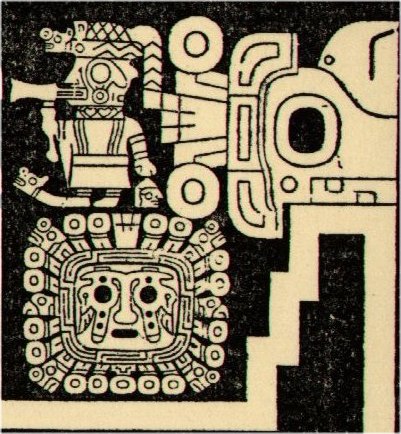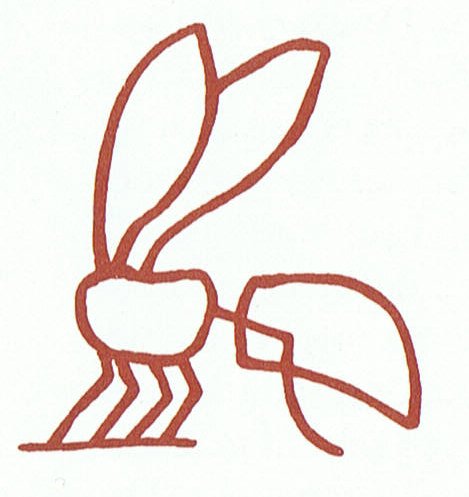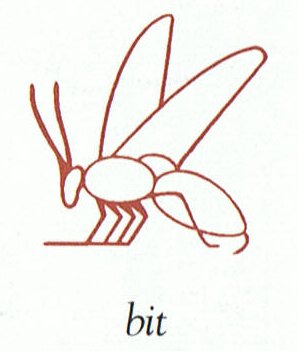There is another
sign in front of
the 'bee' (bit,
the Egyptian
name of the
insect):

According to
Wilkinson the
sign depicts
sedge (nesu),
and one of the
names of pharaoh
was nesu-bit,
'he of sedge and
bee':

Sedge was a sign
for Upper Egypt
and the bee a
sign for the red
crown of
pharaoh,
symbolizing
Lower Egypt.
Although
Wilkinson admits
that the role of
the bee in this
connection is
'not quite fully
understood'
(i.e. the
experts are
totally in the
dark), I think its role
should be fairly easy
to understand:
1. Manu rere
(GD11), I have
suggested,
represents the
'top bird' - a
fitting
description of
pharaoh.
|
...
Several
of
the
early
missionaries
comment
with
a
fine
sense
of
humor
upon
the
mistake
the
islanders
made
in
calling
the
cow
when
first
seen
a
bird.
This
is
the
word
which
led
the
good
missionaries
into
the
error
of
their
own
ignorance.
Manu
is
as
wholesale
in
its
signification
as
our
word
animal,
it
is
generic.
In
the
paucity
of
brute
mammalia
the
first
missionaries
found
this
general
term
most
frequently
used
of
birds,
and
it
was
their
and
not
a
Polynesian
mistake
to
translate
manu
into
bird.
In
the
material
here
collected
it
will
be
seen
that
the
significations
animal
and
bird
are
widely
extended.
In
the
Paumotu
insects
are
included;
the
same
is
true
of
Mota,
where
manu
signifies
beetle
as
well
as
bird
...
|
2. The role of
pharaoh is to
ensure growth,
to take on the
habit of the
insect.
|
...
From
a
religious
point
of
view,
the
high
regard
for
flies,
whose
increase
or
reduction
causes
a
similar
increase
or
reduction
in
the
size
of
the
human
population,
is
interesting,
even
more
so
because
swarms
of
flies
are
often
a
real
nuisance
on
Easter
Island,
something
most
visitors
have
commented
on
in
vivid
language.
The
explanation
seems
to
be
that
there
is a
parallel
relationship
between
flies
and
human
souls,
in
this
case,
the
souls
of
the
unborn.
There
is a
widespread
belief
throughout
Polynesia
that
insects
are
the
embodiment
of
numinous
beings,
such
as
gods
or
the
spirits
of
the
dead,
and
this
concept
extends
into
Southeast
Asia,
where
insects
are
seen
as
the
embodiment
of
the
soul
... |
|
...
Although
this
species
of
fig
requires
the
presence
of
the
symbiotic
wasp
Ceratosolen
arabicus
to
reproduce
sexually,
and
this
insect
is
extinct
in
Egypt,
Zohay
and
Hopf
have
no
doubt
that
Egypt
was
'the
principal
area
of
sycamore
fig
development
... |
3. The necessary
'sting' of
pharaoh (to
enforce his
will, should
there be any
dissension) is
his vero
(as if he was a
gladiator):
|
sedge
...
coarse
grassy
rush-like
or
flag-like
plant
...
IE.
*sek-,
repr.
by
L.
secāre
...
For
the
etymol.
notion
of
'plant
with
cutting
edge',
cf.
L.
gladiolus
(f.
gladius
sword),
which
the
OE.
word
renders
in
glosses,
and
OE.
sećģ
fem.,
sword
...
(English
Etymology)
Pharaoh
has
two
'swords'
-
one
at
the
front
(nesu)
and
one
at
the
end
(bit)
-
nesubit
=
'the
two
swords'. |
4. Pharaoh
resembles the
sun in his force
and splendour,
therefore he
must (like the
sun) be
'disarmed' ('off
with his head')
at summer
solstice.
|
 |
|
Wilkinson:
"In
spite
of
the
positive
associations
and
beneficient
usefulness
it
was
still
an
insect
which
could
sting.
In
the
pictures,
as
well
as
in
hieroglyphic
writing,
they
had
often,
therefore,
systematically
deleted
the
head
of
the
insect
to
make
the
picture
harmless
..."

I
think
this
was
a
stupid
remark.
Everyone
knows
that
the
sting
of
an
insect
is
located
at
the
other
end
of
its
body.
The
sting
may
still
be
there
in
the
picture
(cfr
comments
at
p. 5
below).
Instead,
the
probable
meaning
of
the
loss
of
its
head
is
that
the
'wasp'
must
die
inside
the
fig
in
order
for
a
proper
growth.
That
is
necessary.
"...
The
fig
fruit
is
in
fact
an
enclosed
inflorescence,
sometimes
referred
to
as a
syconium,
an
urn-like
structure
lined
on
the
inside
with
the
fig's
tiny
flowers.
The
unique
fig
pollination
system,
involving
tiny,
highly
specific
wasps,
know
as
fig
wasps
that
enter
these
closed
inflorescences
to
both
pollinate
and
lay
their
own
eggs,
has
been
a
constant
source
of
inspiration
and
wonder
to
biologists
..."
(Wikipedia) |
5. The legs of
insects are 6 in
number - as
everone knows -
yet in the
Egyptian bit
pictures they
have only 4
legs, a sign
that the insect
in question is a
symbol (not a
picture of the
real insect).
|

Here
the
intact
insect
has
its
sting
clearly
located
at
its
end.
4
legs
are
in
contact
with
the
ground
and
2
legs
(though
only
1 is
seen)
are
uplifted.
Between
the
front
'body'
(i.e.
not
the
head
but
the
middle
oval)
and
the
back
'body'
an
interesting
sign
is
seen,
as
if
it
was
the
sun
itself
hiding
on
the
back
side
of
the
bit.
In
the
headless
variant
above,
sun
has
disappeard
together
with
the
head.
On
the
other
hand,
a
diamond
shape
(possible
meaning
the
fertilized
land)
is
formed
by
the
back
leg
and
the
outline
of
the
back
'body'.
We
now
can
guess
why
there
are
only
4
'limbs'
in
Aa1-5--8:
They
represent
those
legs
of
the
'sun
insect'
which
are
in
contact
with
earth.
The
'elbows'
oriented
leftwards
means
that
the
'head'
of
the
sun
is
at
right
(i.e.
at
summer
solstice). |
6. The number
patterns must be
considered, and
we find (in
Wilkinson's
examples of
swarms of bees)
10 + 2 = 12 and
10 + 1 = 11,
where (probably)
10 means the
full amount of
sun.
|

According
to
Wilkinson
both
the
horizontal
'barrels'
at
bottom
(8)
and
the
vertical
containers
at
the
top
(6)
are
bee-hives.
Earth
is
horizontal
in
the
bottom
picture,
while
in
the
honey-gathering
phase
(the
top
picture)
earth
is
leaning
downwards.
We
therefore
ougth
to
read
the
bottom
picture
first
-
solstice
comes
before
'p.m.'.
The
bottom
picture
(with
8
'barrels'
and
10
'bees'
at
right)
obviously
refers
to
the
sun,
while
the
top
picture
has
6
containers
at
left
(meaning
'past')
and
7 +
3
'bees'
at
right,
presumably
referring
to
the
2nd
half
of
the
year,
ruled
by
the
moon.
The
6
containers
at
left
have
signs
which
we
count
to
7.
These
signs
are
not
distributed
randomly
and
there
certainly
is
more
informatin
to
be
gained
from
the
pictures.
"...
the
bee
was
...
a
suitable
symbol
for
the
fruitfulness
and
generosity
of
nature.
And
in
the
Book
of
Gateways
it
is
said
that
when
the
sun
god
enters
into
the
first
'circle'
of
the
eighth
'hour'
in
the
underworld,
the
gods
Tem,
Chepri,
and
Schu
-
which
all
in
one
or
the
other
way
symbolize
this
quality
-
respond
to
the
great
Ra
with
a
voice
which
resembles
the
hum
from
many
bees
..." |





